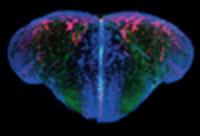Topic 1: Biological Networks and Synthetic Regulators
The overarching aim of Topic 1 is to develop innovative tools and approaches to manipulate cells within an organism in order to control tissue formation, repair and regeneration. This challenge requires profound knowledge of cell behaviour. Based on our expertise, we study in particular three complementary biological systems, which allow us to tackle different facets of regeneration in vivo: (i) the neural system, which has very limited regeneration capacity in mammals but can fully regenerate in lower vertebrates such as zebrafish and (ii) the skeletal muscle system, which can regenerate extensively. Common elements involved in the regeneration of these two systems are specialized adult stem cells, and controlling the fate of these cells represents one logical strategy for future regeneration therapies. Finally, we study (iii) the innate immune system, which can initiate regeneration processes but can also be detrimental if uncontrolled.
Within the three systems, our first aim is to identify specific key control points which could be harnessed to manipulate tissue formation and regeneration. To achieve this goal, we tackle in particular the following questions:
- What are the key control points which operate during tissue formation in embryogenesis? Can they
 be exploited in strategies aimed to promote regeneration?
be exploited in strategies aimed to promote regeneration? - What are the molecular mechanisms which enable central nervous system regeneration in species such as zebrafish? Can we use this knowledge to promote regeneration in the mammalian brain?
- Which specific regulatory elements of the innate immune system favour regeneration? Can we dissociate them from deleterious inflammatory effects?
- What are the key control points underlying the activation and differentiation of stem cells? Can they be harnessed to control regeneration in vivo?
The identification of these control points first entails the acquisition of knowledge on a large scale using unbiased screening approaches in vivo. The next step is to scrutinize the identified control points in order to understand their function at the molecular level and define unique interfaces for their manipulation in vivo. This knowledge is harnessed for the rational development of novel synthetic tools and approaches (e.g. small chemical compounds, synthetic biology approaches) to manipulate cells at the molecular level in the organism in an efficient and specific manner. These tools and principles will find applications in biomedicine, in particular in regenerative medicine but also in biotechnology.
To achieve its goals, Topic 1 sets as a priority the tailored development of enabling technologies. These transdisciplinary activities are rationalized and coordinated by a Screening and an Imaging Hub. Furthermore, activities in Topic 1 rely upon essential technology platforms, namely the Compound platform (ComPlat), the Bioinformatics platform, the European Zebrafish Resource Center and the OMICS platform.
|
|
